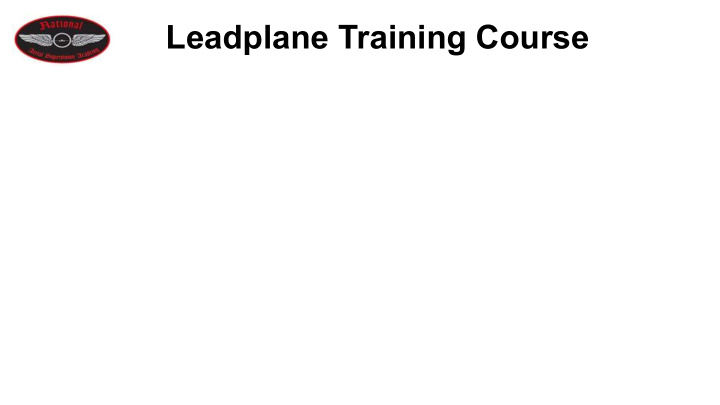



Leadplane Training Course
Leadplane Training Course Communications Linking your communications to the pattern.
Leadplane Training Course Communications Learn to be predictable with your communications by linking them to the leadplane pattern. Develop consistent verbiage patterns to minimize workload. Develop consistent verbiage patterns to minimize omitation of information.
Leadplane Training Course Initial Briefing (Initial call) “Tanker 65, 12 miles.” “Tanker 65, 29.92, Cleared in 6500, Airattack at 7500, 2 helicopters 4000 and below, Power lines east of the fire.”
Leadplane Training Course Outbound for the join up Location and Altitude. “Tanker 65, 11 o’clock, 6000.” (500 foot minimum separation.)
Leadplane Training Course The join up at 2 miles Location and Action. “Tanker 65, 11 o’clock, Here is a wing and smoke.”
Leadplane Training Course Inbound to the downwind. Give objective for the drop. “Working direct, left shoulder, tagging and extending existing retardant.”
Leadplane Training Course Inbound to the downwind. Give special instructions. “We will be in a right hand pattern.”
Leadplane Training Course Entering the downwind. Start the Tactical Briefing
Leadplane Training Course Tactical Briefing Orientation, Specific Hazards, Objectives, Target Description, Coverage level, Portion of load, Exit Instructions, Clearance to Maneuver Clearance to Drop
Leadplane Training Course Tactical Briefing “Tanker 65, do you have the structure on the Left flank? Caution power lines along the road, Objective is structure protection, V the structure, Coverage level 8, Split load, Exit left at or below 3000 feet, Helicoptors on the right.”
Leadplane Training Course Tactical Briefing The tactical briefing should be tied to each leg of the pattern during a show me. Doing this gives the student an association (legs of the pattern) with each communication (tactical briefing script). Information is less likely to be missed and the tanker pilot will have a visual reference to associate with tactical briefing information.
Leadplane Training Course Objective Examples Direct or Indirect. Left or Right, Heel, Flank or Shoulder. V the Heel or V the Head. Tag and Extend. Box the fire in. Starting a new retardant line.
Leadplane Training Course Downwind Call out “abeam.” Location, profile, drop heading, drop altitude, speed request. “Downwind for a show me, drop heading 180, drop altitude 5000.” Start Point
Leadplane Training Course Base After establishing the downwind leg communicate your intentions. “Turning base for a show me.” Start point, “Tag and Extend.”
Leadplane Training Course Start Point Examples Tag and extend. Tag and extend, bend it left 10 degrees. Start at the white rock, keep it on the ridge. Start at the buck skin snag. Start at the timber grass break. Anchor to the scree.
Leadplane Training Course Final for a Show Me “Turning final for a show me.” “This is the line, Start here.”
Leadplane Training Course The Exit “On the exit I’ll be up and left, you are straight out, plan a load and return.” “If you keep me insight I’ll meet you at 6000 what speeds would you like?”
Leadplane Training Course “Abeam.” “Starting a turn to base.” “Downwind.” Downwind for a Live Run
Leadplane Training Course Base for a Live Run “Starting my turn to final.”
Leadplane Training Course Final for a Live Run “On final, This is the line, Start here.”
Leadplane Training Course Departure Briefing Drop Evaluation Start Line End Instructions Load and return or hold Location
Leadplane Training Course Departure Briefing “Tanker 65, depart to the west, maintain 3000 until Clear of the FTA, Load and return.”
Leadplane Training Course The Drop Evaluation Evaluate the start point and the line location. “Quarter of a load late, good line.”
Leadplane Training Course Summary Being predictable is the key to being an efficient leadplane pilot. Link your communications to the legs of the pattern. Formulate consistent verbiage patterns. This will lower your workload for other tasks.
Recommend
More recommend